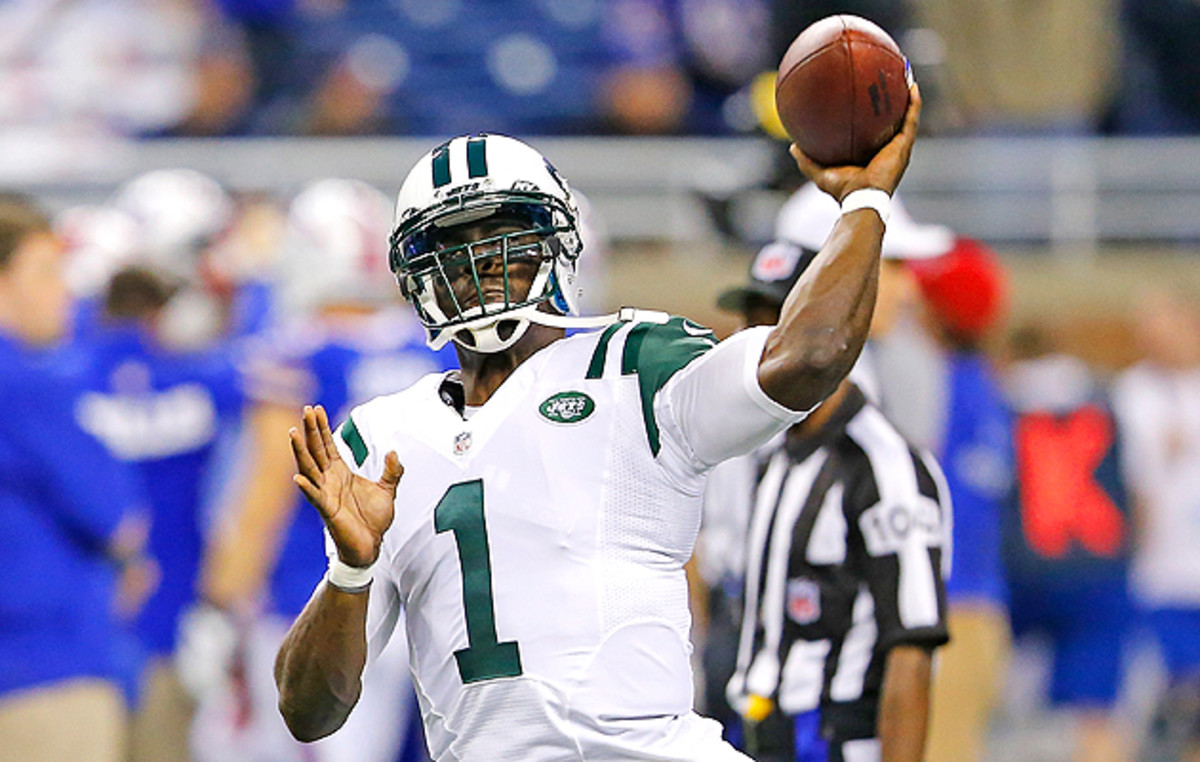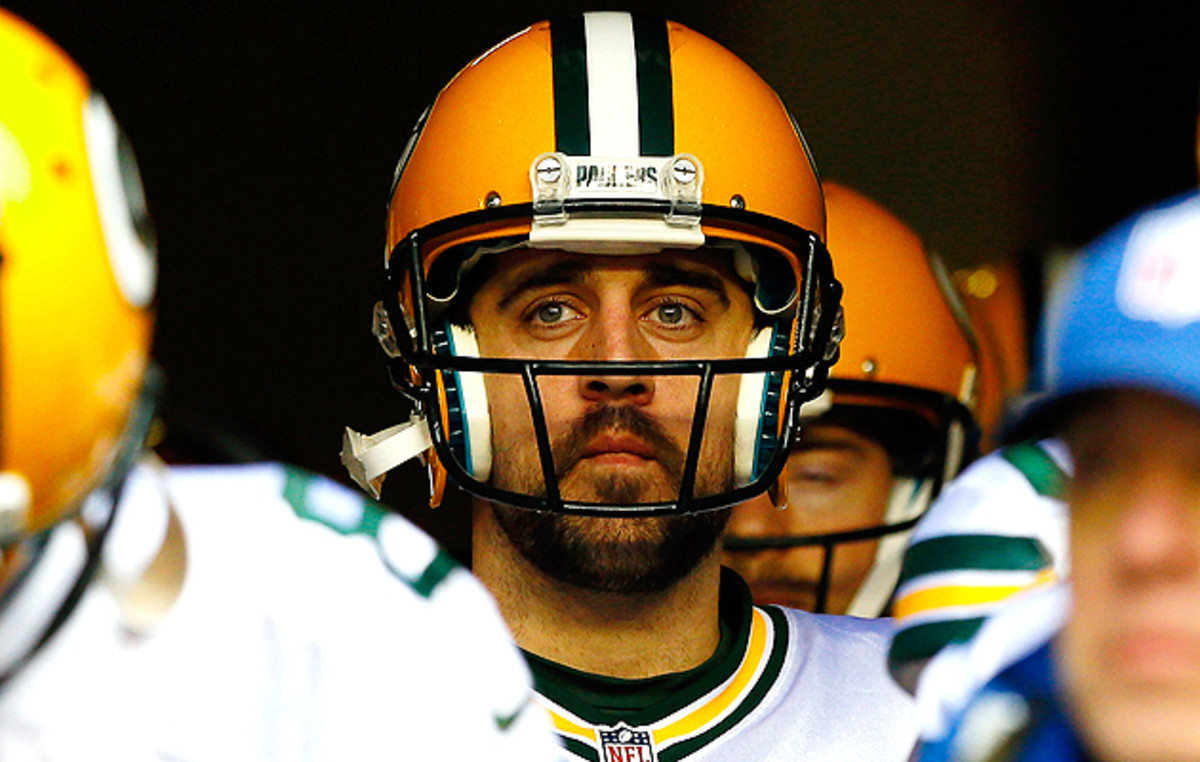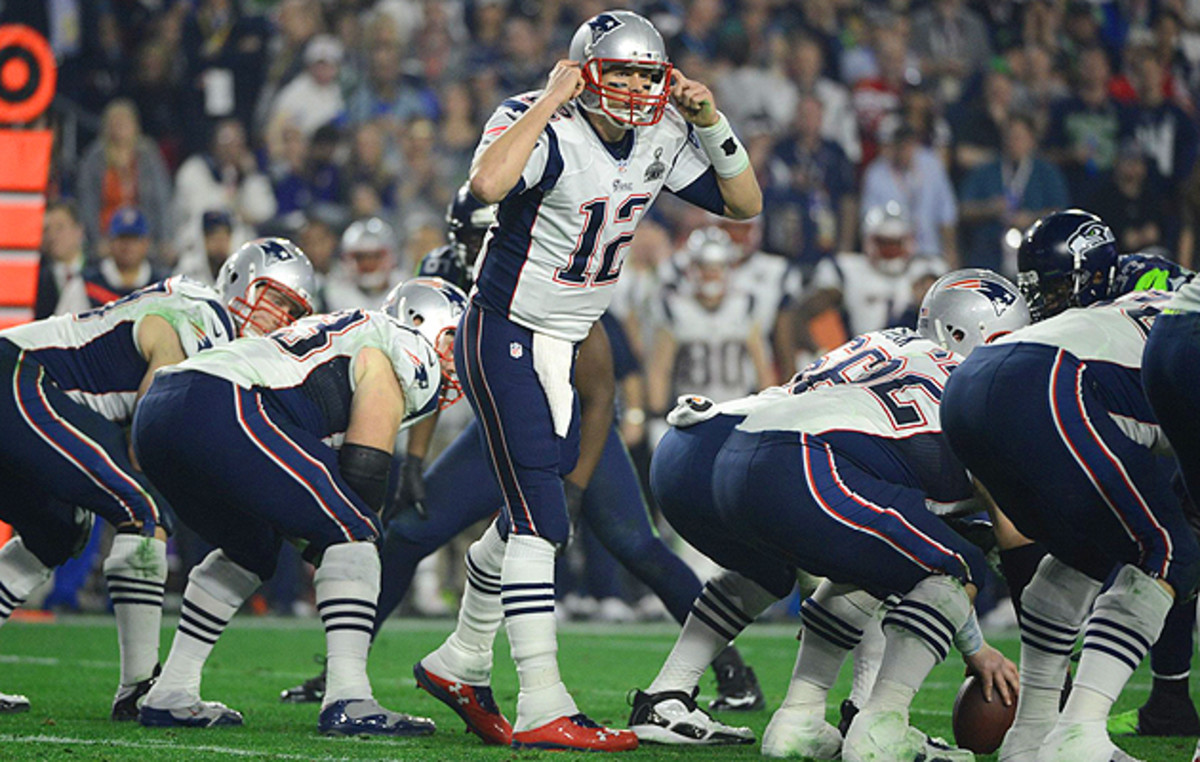Building the perfect NFL quarterback

If you were to search the invaluable Pro Football Reference for games since 1960 in which a quarterback threw at least 10 passes and completed all of them, this is what you will find:

One. It has happened once. Kurt Warner, while playing for the Arizona Cardinals in 2005, completed 10 of 10 passes for 115 yards and a touchdown. The Cardinals lost that game (30–19) and Warner missed the second half after suffering a season-ending knee injury. The official NFL record book requires a minimum of 20 passes for the single-game completion percentage mark. Warner actually holds that record, too: 92.3% (24 of 26 vs. Jacksonville in 2009).
The point being, quarterback perfection is a myth. The greatest quarterbacks in NFL history have had shoddy games, and even when they are electrifying, it does not take much for a couple of incompletions to pile up or an interception to occur.
• SI.com's off-season report cards: Grading every team's moves
However, the quest for perfection never ends. NFL teams, especially those unhappy with their current arrangements under center, search high and low for a quarterback who fits the ideal prototype. If they get lucky any player they find will feature a few of the desired traits—height, arm strength, running ability, etc.
What might the mythical flawless quarterback look like, then? Considering only quarterbacks who are still active today, a little something like this:

Right arm:Joe Flacco
Picking the right candidate here all boils down to what you're looking for in a throwing arm.
Off-season Sour Rankings: Brady's moves, Manziel's money sign
For example, Brian Hoyersaid last year that his Texans teammate, Ryan Mallett, has the "strongest arm I've ever seen". Matthew Stafford features a howitzer, as does NFC North rival Jay Cutler—both quarterbacks can fire off a bomb without coming anywhere close to proper throwing technique, and each has thrived at stretching the field. Logan Thomas (60 miles per hour) and Colin Kaepernick (59 mph) hold first and second place, respectively, in combine history for fastest pass.
So why Flacco? Because he is more proficient than any of the names mentioned above at backing his arm with accuracy. Flacco can go sideline to sideline with his passes or uncork a 70-yarder with equal confidence. He usually placing those deep balls where only his receiver can make a play, hence the whopping number of pass interference calls Flacco and Torrey Smith combined to draw in past seasons.
There are other quarterbacks capable of hitting the deep ball who are better at short and intermediate passes—Aaron Rodgers springs to mind immediately, as he should in most conversations here. If we're starting from scratch constructing a QB, though, we would want to maximize reliable downfield arm strength. Flacco's the guy.

Left arm:Michael Vick
If the idea is to build a perfect quarterback, might as well make him ambidextrous, right?
Vick does not currently have a team and his NFL career may be over, so put an asterisk next to his name as the goal is to use active players for this exercise. Behind him on the southpaw arm strength chart right now would be ... uh... Tim Tebow? Kellen Moore? It's a long fall.
Vick does not get the nod here simply by default. When he was in his prime a decade or so ago, Vick was perhaps the best athlete we'll ever see at the quarterback position. Even now, at age 35, he at least maintain a huge throwing arm, even if the total package no longer shines as it once did.
Accuracy was never really his forte—Vick has posted a completion percentage north of 60 just once since his NFL career began in 2001. But he always has been able to generate incredible heat with a quick-release motion, be it threading the needle or taking a shot downfield.

Head: Peyton Manning
It is never easy to fully appreciate a player while his career is ongoing. Anyone who has followed Manning's career knows that he is, without question, one of the best quarterbacks of all time and yet, all the Peyton-centric discussion topics ahead of the 2015 season deal with his diminishing physical skills.
Regardless, know this: Manning is perhaps the smartest on-field quarterback in the history of the league. Here's Seahawks CB Richard Shermanon Manning, from January of 2014:
Roundtable: Which NFC East QB has the most at stake in 2015?
"When we played Peyton in the preseason, I found a new appreciation for the way he makes adjustments at the line of scrimmage; he controls the protections, and if he sees the blitz coming he slides it. The thing that sets him apart is that he’ll change it to a run play if you don’t have enough players in the box, and they’ll get five or six yards because you’re not ready for it. Nobody else has both the authority to do that within their offense and the understanding to know when it’s appropriate."
Manning's pre-snap routine is legendary. (Remember "Omaha! Omaha!"?) He possesses a preternatural ability to diagnose defenses before plays happen, thereby allowing him—as Sherman pointed out—to counter with adjustments only the most savvy quarterbacks can put into practice.
Were it not for his ability to win the mental aspects of the game, Manning's career may have petered out long ago, and it never would have reached the heights it has.

Eyes: Aaron Rodgers
In all honesty, the prototype quarterback could feature myriad Rodgers attributes. He has a deadly accurate arm, enough mobility to keep defenses honest, borderline Manning-like control over the game and an unquenchable will to win. Oh, and there is not a more effective quarterback in football at throwing on the run.
His eyes—his ability to see the field—makes everything else tick.
"He’s the type of guy when if you make a mistake, he’s going to find it," Jets linebacker Calvin Pace said in 2014, per his team's website. "The fact that he can extend a play makes it tougher for the guys on the back end. You can’t cover forever."
MythBusters: Secondary issues, not Brady's absence, could doom Patriots
Somehow, the Packers' QB manages to stay one step ahead of opposing defenses. Remember his clutch, fake-spike completion to Davante Adams vs. Miami last season? Rodgers set that up with little more than a glance Adams' direction. When Rodgers took the snap, only he, Adams and Randall Cobb even moved for the Packers; the other eight offensive players assumed Rodgers was following through with spiking the football to stop the clock.
Those plays on the run don't just happen either. A flaw in many quarterbacks is the tendency to drop their eyes in the face of pressure, looking for somewhere to escape. Rodgers manages to sidestep rushes while still scanning the field, giving his receivers extra opportunities at finding space.
Even minus an arm on par with guys like Flacco, Cutler or Stafford, Rodgers rarely has trouble testing defenses long. Combine one of those cannons with Rodgers' unmatched knack for finding his targets and there would be no stopping the passing attack.

Build:Cam Newton
There are not many humans built like Cam. Back at the 2011 scouting combine, Newton checked in at 6'5" and 248 pounds. The Panthers now list him at 6'5", 245—a more cut physique than Newton showed off coming out of college.
Quarterbacks of all heights and sizes have found success in the NFL, but this is the ideal frame. Newton has missed just two games over four pro seasons, both coming in 2014. (He sat out Week 1 with a fractured rib, then missed Week 15 following a car accident.) He's capable of absorbing hits—and he took plenty last season behind a porous line—while also handing out some punishment himself.

Hands:Ben Roethlisberger
Bench presses, vertical jumps and 40-yard dashes often hog headlines at the NFL combine. Hand size is one of the elements not made for TV that matter for scouts nonetheless.
Off-season report card: Pittsburgh Steelers
Look no further than how Roethlisberger incorporates pump fakes into his repertoire to understand why. Quarterbacks (and skill-position players, in general) with hands on the smallish side—around nine inches or less—are viewed as greater threats to fumble the football. Roethlisberger not can take care of the football in normal circumstances, he has enough hand strength to be able to hold onto the ball through a full throwing motion, reset and fire.
"Sometimes you're amazed the ball doesn't come out of his hands," then Cincinnati defensive backs coach Kevin Coyle told The New York Times of Roethlisberger, in 2011. "You're always talking to defensive backs about breaking on the quarterback's intentions. And he gives great intentions. But what you see is not what you get. He's like Houdini sometimes."

Legs:Russell Wilson
Wilson took 42 sacks last season, so defenses can get to him and bring him down. Many of those mistakes fall on Wilson's shoulders, too, thanks to his determination to keep plays alive beyond a normal blocking window—Pro Football Focus pinned 10 sacks directly on Wilson.
If a defense misses its shot, though, good night. Wilson rushed for 849 yards last season, good enough for the 17th spot overall on the league's rushing chart. He averaged 7.2 yards per carry, tops among players with enough attempts to qualify for the league-leaders board; Colin Kaepernick finished second, more than a full yard behind Wilson (6.1), followed by Justin Forsett (5.4).
I mean, come on ...
That's a level of elusiveness NFL coaches would be thrilled to have in a running back or slot receiver. Wilson offers it from the quarterback spot.

Feet:Andrew Luck
Obviously, the feet tie into what Wilson can do with his legs (anatomy, FTW!). Specifically, though, feet are part of our Ultimate Quarterback Equation as it pertains to footwork as a passer. Luck already excels with that attribute, and he should only continue to get better.
Stat breakdown: How effectively does YPA reflect a quarterback's success?
No matter what throwing technique a quarterback employs, the process starts from the bottom up. If the feet are askew, driving from the legs becomes more difficult, as does firing the hips open at the proper time, following through and sending the ball on its proper course. It sounds simple, but keeping everything aligned while transitioning from a primary to secondary to tertiary passing option is a critical challenge...and that is without even adding in the pressure of closing defenders.
Luck arrived in the NFL well-versed in a pro-style system—not a requirement for early success, but he did have extensive experience dropping from under center. He's comfortable with the three-, five- or seven-step drops, able to keep his feet moving until he finds a receiver.
The skill Luck has shown as a runner brings an added bonus to the table. Defenses have a hard time limiting him to the pocket, because he can throw on the run or take off and get downfield. Luck is a dual-threat quarterback, even if he is rarely talked about in such terms.

Heart:Tom Brady
Label Brady's portion of our Frankenstein-esque model whatever you want: "heart", "guts", "moxie". Even now, as he prepares to turn 38 years old in August, Brady would be the majority choice of coaches around the league if they needed a quarterback to get them one victory.
There will be a vocal group of Brady critics that forever attach a stigma to his career—there was "Spygate" and now the ongoing deflated-balls controversy. The Patriots deserve to take heat in both instances, and Brady probably does for the latter.
Does that discount his ability to perform in the clutch? His fiery responses when his back is up against the wall? Not even close. Brady is a four-time Super Bowl winner and six-time AFC champion, yet still manages to stoke the fire when necessary. Case in point: the most recent Super Bowl, in which New England trailed Seattle by 10 in the fourth quarter before Brady fired a pair of touchdown passes.
Hate him if you must. Just try to recognize few in NFL history, if any, have been better than him when it counts.
